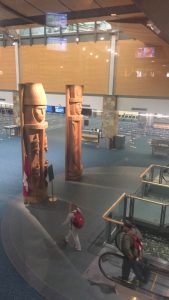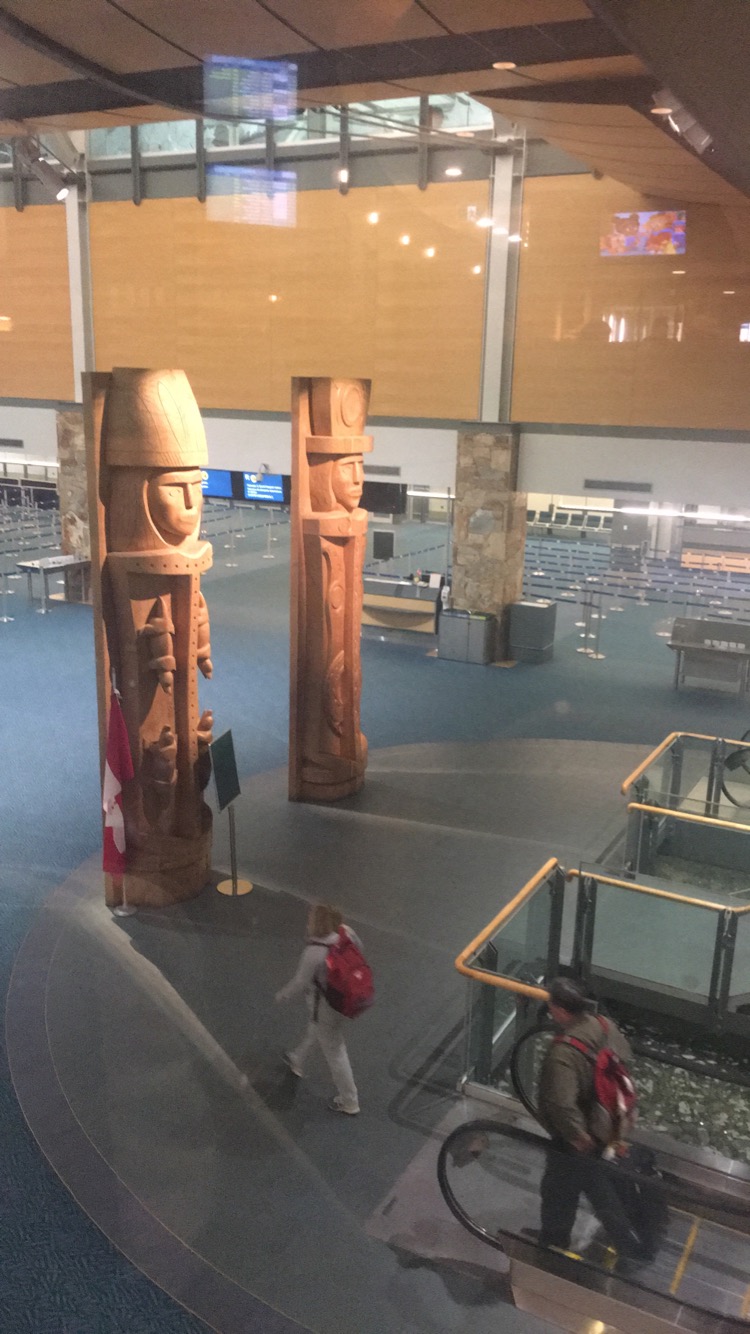Vancouver International Airport as a Crossroads, and a Reminder

I took this photo on my way to Los Angeles in February 2017, right before reading week. Vancouver International Airport (YVR) is a meeting point for diversity, language, culture, and more. The first thing you see when you arrive at customs is a totem pole, reflecting the present culture of the Indigenous people. It is a reminder of the land we are standing on- who it originally belonged to, how immigrants took it, and what we at least silently need to recognize, post-settler colonialism. Here at UBC, classes take place on the unceded territory of the Musqueam people. It is easy to forget what has been done to the aboriginal peoples. Even when they are acknowledged, much goes unaddressed. And many people in the Aboriginal community live in poverty, specifically in the downtown eastside.
Vancouver is a popular site for tourism, boasting its natural beauty and its museums, its proximity to Whistler and other winter destinations, its beaches, its nightlife, etc. Tourists do not come here to address issues like the housing crisis, or the displacement of indigenous people, or to work towards solving the issue of homelessness in the Downtown Eastside. In fact, the DTES is often disregarded completely. I went to the Downtown Eastside with the Helping Hands Foundation and saw the devastating conditions. As we handed out food, people sat on the sidewalks in the rain, shooting up heroin and smoking anything they could get their hands on. It is devastating. A man yelled at us, saying “You stole our land and you are trying to make up for that with juice. What the f*** is that?” I did not get much sleep that night.
I had been ignorant of the issues Vancouver faced in my first term of university. The downtown eastside has different resources available for the impoverished inhabitants of Vancouver, including the Downtown Eastside Women’s Centre- “Founded in 1978, DEWC is one of the few safe spaces within the Downtown Eastside exclusively for self-identified women and their children. High levels of violence, homelessness, addictions and poverty characterize the Downtown Eastside community. Women and children are particularly vulnerable to exploitation, injustice and injury” (Downtown Eastside Women’s Centre, 2017). An epidemic consisting of addiction, mental illness, infectious disease, homelessness, poverty, and more have plagued the city of Vancouver for years and the issue is not going away.
When I arrived in Vancouver for the first time, I was not made aware of the problems the DTES faced. I was just told to see Stanley Park, Granville Island, the Capilano Suspension Bridge, etc.- there was no mention of the downtown eastside. An alternative to simple tourism is what is now called “voluntourism-” the concept of touring a foreign place while also volunteering there- “Socially responsible tourism is rapidly on the rise and is offered both by commercial tour operators as well as non-governmental organizations (NGOs) that work on global human rights issues” (Mahrouse, 2011). While it might be an attractive alternative to simple tourism, “feel good tourism” can be damaging- “Sadly, taking part in international aid where you aren’t particularly helpful is not benign. It’s detrimental. It slows down positive growth and perpetuates the “white savior” complex that, for hundreds of years, has haunted both the countries we are trying to ‘save’ and our (more recently) own psyches” (Biddle, 2014).
It can be easy to overlook all the “bad” when there is so much “good.” But the totem poles seen in YVR are a reminder that the history of Vancouver was not beneficial for all peoples, and that there is still a long way to go. Vancouver holds 2% of the Aboriginal population, while the DTES holds 10% of the Aboriginal population. More specifically, “The Powell Street or Japantown area lies on unceded Coast Salish territory near the early settlements of Hastings Mills and Granville (Gastown).” (Downtown Eastside (DTES) Local Area Profile 2012, 2012).
As citizens of Greater Vancouver, and as students of the University of British Columbia, we must acknowledge our own privilege, and also acknowledge all that has happened, and is still happening, on the territory where we stand, while working towards profound change that can benefit all the people of Vancouver.
Works Cited:
About Us. (n.d.). Retrieved March 26, 2017, from http://dewc.ca/dewcabout
Biddle, Pippa. (2014). The Problem With Little White Girls, Boys and Voluntourism. The Huffington Post.
City of Vancouver. (2012). Downtown Eastside (DTES) Local Area Profile 2012. http://vancouver.ca/files/cov/profile-dtes-local-area-2012.pdf
Mahrouse, Gada. (2011). Feel-good tourism? An ethical option for socially-conscious Westerners. ACME, 10(3): 372-391.
